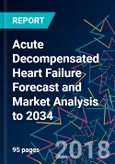Disease Overview
Acute decompensated heart failure (ADHF) is defined as the sudden worsening of heart failure symptoms (mainly edema, dyspnea, and fatigue), which results in severe respiratory distress. ADHF is categorized into hemodynamic stages based on the degree of perfusion and pulmonary capillary wedge pressure. Despite improvements in treatment, ADHF is a burdensome disease associated with high hospitalization and mortality rates in the elderly population.
Recent events and opinion
Acute decompensated heart failure (ADHF) is defined as the sudden worsening of heart failure symptoms (mainly edema, dyspnea, and fatigue), which results in severe respiratory distress. ADHF is categorized into hemodynamic stages based on the degree of perfusion and pulmonary capillary wedge pressure. Despite improvements in treatment, ADHF is a burdensome disease associated with high hospitalization and mortality rates in the elderly population.
Recent events and opinion
- ADHF treatment is focused on hemodynamic stabilization and alleviation of symptoms.
- The author estimates that in 2016, there were 1.2 million diagnosed incident cases of ADHF in the US, Japan, and five major EU markets.
- Natrecor and Simdax have had limited success in the highly genericized ADHF market.
- Discontinuations of ularitide and Reasanz have left the ADHF pipeline bare.
Table of Contents
1 Treatment: Acute Decompensated Heart Failure (Published on 19 January 2018)- Executive Summary
- Primary Research Methodology
- Disease Definition and Diagnosis
- Current Treatment Options
- Prescribing Trends
2 Epidemiology: Acute Decompensated Heart Failure (Published on 18 January 2018)
- Executive Summary
- Disease Background
- Sources And Methodology
- Forecast
- Epidemiologist Insight
- Strengths And Limitations
- Bibliography
- Appendix: Additional Sources
3 Marketed Drugs: Acute Decompensated Heart Failure (ADHF) (Published on 15 February 2018)
- Executive Summary
- Product Overview
- Diuretics
- Vasodilators
- Inotropic Agents
- Other Drug Classes
- Product Profile: NATRECOR
- Product Profile: SIMDAX
4 Pipeline: Acute Decompensated Heart Failure (ADHF) (Published on 15 February 2018)
- Executive Summary
- Clinical Pipeline Overview
- Recently Discontinued Drugs
- Product Profile (Late Stage): BMS-986231
List of Figures
Figure 1: Typical treatment flow for initial management of a patient hospitalized with suspected ADHF
Figure 2: Clinical profiles of patients with acute heart failure based on the presence/absence of congestion and/or hypoperfusion
Figure 3: Percentage of ADHF patients receiving each treatment type, by country
Figure 4: Percentage of ADHF patients receiving each type of non-pharmacological therapy, by country
Figure 5: Percentage of first-line ADHF regimens containing each drug class, by country
Figure 6: Use of each diuretic class as a percentage of total diuretic use for the first-line treatment of ADHF, by country
Figure 7: Use of each vasodilator as a percentage of total vasodilator use for the first-line treatment of ADHF, by country
Figure 8: Use of each inotropic agent as a percentage of total inotropic use for the first-line treatment of ADHF, by country
Figure 9: Percentage of regimens for the treatment of ADHF containing Entresto, by line of therapy and country
Figure 10: Top three first-line regimens for ADHF, by country
Figure 11: Percentage of ADHF patients moving on to second-line therapy who were responsive or non-responsive to firstline therapy, by country
Figure 12: Percentage of second-line ADHF regimens containing each drug class for patients who show a response to firstline treatment, by country
Figure 13: Percentage of second-line ADHF regimens containing each drug class for patients who do not show a response to first-line treatment, by country
Figure 14: Trend in diagnosed incident cases of ADHF in the US, Japan, and five major EU markets, by country, 2016-36
Figure 15: Absolute change in diagnosed incident cases of ADHF in the US, Japan, and five major EU markets, by country, 2016-36
Figure 16: Natrecor for ADHF - SWOT analysis
Figure 17: The author’s drug assessment summary for Natrecor in ADHF
Figure 18: The author’s drug assessment summary for Natrecor in ADHF
Figure 19: Simdax for ADHF - SWOT analysis
Figure 20: The author’s drug assessment summary of Simdax for ADHF
Figure 21: The author’s drug assessment summary of Simdax for ADHF
Figure 22: BMS-986231 for ADHF - SWOT analysis
Figure 23: The author’s drug assessment summary of BMS-986231 for ADHF
Figure 24: The author’s drug assessment summary of BMS-986231 for ADHF
List of Tables
Table 1: Cardiologists surveyed for the ADHF primary research study, 2017
Table 2: Common triggers of ADHF
Table 3: Mean percentage of ADHF patients who have risk factors/co-morbidities in the US, Japan, and five major EU markets, by country
Table 4: Treatments available for ADHF across the US, Japan, and five major EU markets
Table 5: Percentage of first-line ADHF regimens containing each drug class, by country
Table 6: Sources used for the epidemiological analysis of ADHF in the US, Japan, and five major EU markets, by country
Table 7: Diagnosed incident cases of ADHF in the US, Japan, and five major EU markets, by country, 2016-36
Table 8: Age-specific diagnosed incident cases of ADHF in the US, Japan, and five major EU markets, by country, 2016
Table 9: Gender-specific diagnosed incident cases of ADHF in the US, Japan, and five major EU markets, by country, 2016
Table 10: Profiled key marketed drugs for ADHF
Table 11: Diuretics class overview
Table 12: Vasodilators class overview
Table 13: Inotropic agents class overview
Table 14: Other drug classes overview
Table 15: Natrecor drug profile
Table 16: Natrecor Phase III data in ADHF
Table 17: Simdax drug profile
Table 18: Simdax Phase III data in ADHF
Table 19: Profiled pipeline products in development for ADHF
Table 20: Late-stage compounds that were recently discontinued for ADHF
Table 21: Reasanz drug profile
Table 22: Ularitide drug profile
Table 23: BMS-986231 drug profile
Table 24: BMS-986231 Phase II data in ADHF
Table 25: BMS-986231 Phase II trials in ADHF








